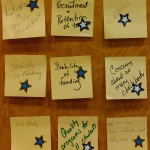
None of the three sessions I attended Tuesday here in Aberdeen fit that description. The meetings played out like an honest attempt to solicit input from the citizens in attendance on three questions, the same questions posed at all eighteen sessions around the state:
- When you think about funding in your local community, what is important to you?
- What ideas or new approaches might make those priorities more possible for schools in your community?
- What advice do you offer to the Task Force as the work moves forward?
I didn’t see dogs or ponies, just sticky notes. Participants sat in different small groups for each question. They wrote down each noteworthy point of their discussions on sticky notes. They then starred the three most important responses their table produced for display on the wall. (I have altered some of the photos to reduce size; I have not altered the text appearing on the notes; click each to embiggen!)
 |
 |
 |
 |
 |
 |
 |
 |
 |
Two TIE staff—current director Julie Mathiesen and former director turned senior consultant Jim Parry—will transcribe and analyze every sticky note, starred or not, from all sessions to identify major themes. They’ll come up with themes as obvious in the Aberdeen session as in the Watertown sessions the day before. Paraphrasing from a summary provided by a correspondent who attended one of the Watertown sessions, I predict the six big idea walls will boil down to this sentence:
The task force needs to identify new revenue streams to provide stable, consistent K-12 funding sufficient to recruit and retain qualified teachers.
That’s a very small verbal precipitate from a big swirling solution of conversation and sticky notes. It does not capture the most vivid anecdote I heard all day in Aberdeen, a story that won’t fit on a sticky note but captures South Dakota’s K-12 funding problem in toto:
A superintendent was driving down the highway and had to stop for road construction. The flagger noticed the superintendent’s school plates and asked where he worked. They got to talking, and the superintendent learned the flagger was a South Dakota native who moved back here with his wife after teaching special ed in Alaska for a few years. The superintendent said he knew of 29 special education openings around South Dakota and asked the flagger if he’d applied. The flagger said no way—why would he, when he can make more flagging cars all construction season?
The TIE folks will honestly analyze the qualitative data produced by the World Café conversations the Blue Ribboneers hosted for us this month. But their data will not tell us anything the flagger’s story does not. We aren’t paying teachers enough to compete with other jobs in state, let alone teaching jobs out of state. Every teacher knows this. Every administrator knows this. Even every legislator who doesn’t want to do anything about the problem knows this.
The problem is as obvious as the solution: put more money toward schools. The specific legislation that would enact that solution won’t come from one-off public brainstorming sessions. Good public policy comes from ongoing conversations among colleagues who meet regularly, step back to study and think, then get together again and again until they can draft a specific proposal that experts and the general public can digest and debate.
The Blue Ribbon listening sessions weren’t a dog-and-pony show… unless we were the dogs and ponies, meant to enjoy the public display of our voices before the task force gets to its real work. But if only one story, like the flagger story, comes out of these sessions and sticks in the handpicked task force members’ minds, they’ll be able to end our Legislature’s and Governor’s complacency and propose a real solution to South Dakota’s teacher shortage.
We’ll know the true value of this exercise nine months from now, when the 2016 Legislature gavels out.
as much as i think you are a Democratic squish, Cory your graphic for this post is perfect. carry on.
The whole issue boils down to supply and demand. Young people entering college will not enter the teaching profession if they can’t make a decent living at it. What young person is going to want to move to Jones County (population <1000) for a starting wage of $30,000+ when they can live in Spearfish or Rapid City and make more in a summer of flagging?
This whole task force might give a bad name to what was once one of the best beers that was brewed.
Sorry, we don’t need flaggers to turn back into teachers. Rather, we need teachers that that have a passion for teaching, and we need to pay them a livable wage. The flagger should keep flagging and stop flapping his gums.
How about a state-wide salary schedule for teachers? http://www.kitsapsun.com/opinion/our-view-about-time-to-reduce-levy-load_56217371
That is a great graphic Cory. Nicely done.
I have nothing to say about the blindingly obvious consensus of the meeting.
Yes, Lar and Ms. Geelsdottir are right about the beer. I find it hard to believe that they served free beer at these events but I suppose since they are trying to attract as many people from the different spectrums of the Rainbow free beer isn’t a bad idea.
It just better not be paid for with my tax dollars. Because I want my tax dollars going to good teachers. I want MINE going to the VERY BEST teachers, in fact. The rest of you libbies can send your money for government provided free beer but I earn my own in that realm.
Or, when Lar is in town he buys. He’s still paying off a debt to me from many years ago.
What’s really sad is the weak foundation that is supporting all of the bricks (ideas, sticky notes, what have you) of the task force. That foundation is, specifically, the will of the legislature and governor to work toward a viable solution. It is sorely lacking, and about as reliable as shifting sand. And who knows? As the task force meets, will many of our lawmakers be traveling to fancy, secret ALEC meetings to get their heads filled with ideas and draft bills that will simply undo whatever good may come from this dog and pony show?
I like the LEAN idea that was put up by one of the business people. I have been seeing the LEAN/Six Sigma processes being brought into the publicly funded realm more and more lately. It is great for public entities, especially the high cost ones, to give evidence that they are addressing inefficiencies rather than just requesting more money to cover up a broken system.
Combine a LEAN/Six Sigma study with the increases in funding and we could be better positioned to reach our teacher salary/educational outcome goals.
After 20 years of cutting waste and then cutting lean in school districts, I think the entire LEAN idea would be the first thing we ought to put on the chopping block for schools. It would be one gigantic waste of resources (time and money) to implement that.
If you look at the map provided at http://ticas.org/posd/map-state-data and see that the average student loan of a South Dakota is $25,750, would you go into a career where you are pushing up against the general rule of thumb that you shouldn’t take out more than 100% of your salary? I don’t know the average starting salary of a teacher in South Dakota, but I have heard anecdotal evidence of wages close to that mark in the remote areas of the state. In essence, state legislators are asking young people to take a tremendous personal and financial risk in becoming a teacher. In a state that prides itself on financial prudence, this is appalling.
Also, the LEAN philosophy will not work in an educational setting. From my experience at Daktronics in Brookings, LEAN is mostly concerned with reducing inventory levels (Just-in-Time Inventory) and monitoring things like the number of staples, pens, and post-it notes (oh the irony) used by staff.